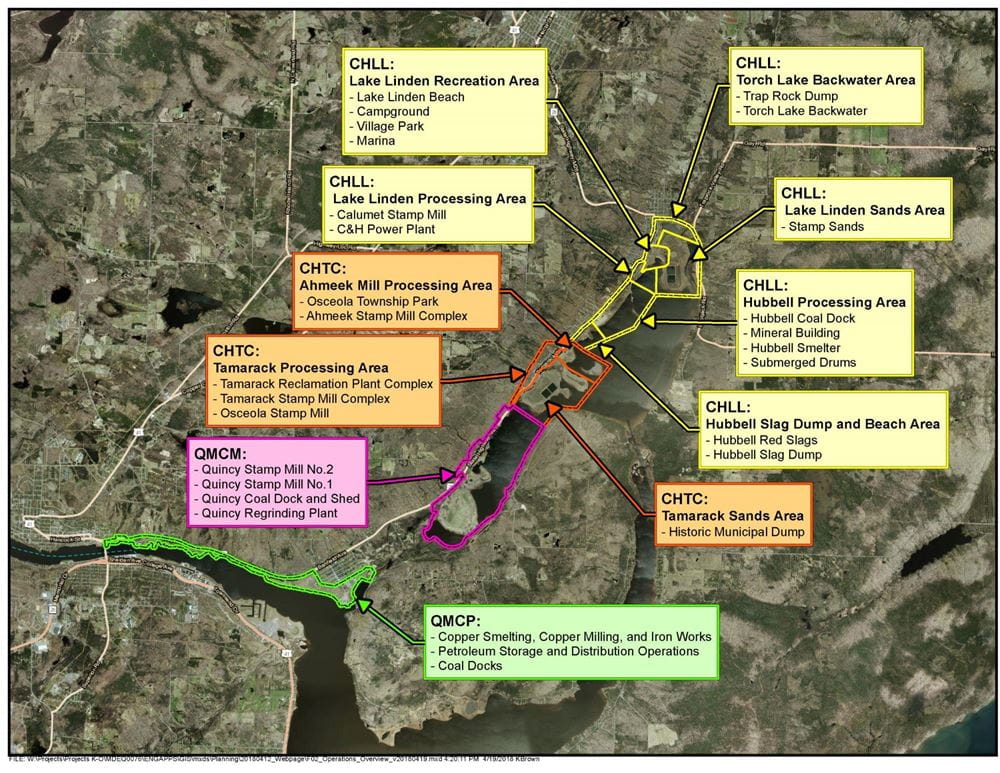The web Browser you are currently using is unsupported, and some features of this site may not work as intended. Please update to a modern browser such as Chrome, Firefox or Edge to experience all features Michigan.gov has to offer.
Project Area and History
The lands and waterways throughout Houghton County were the location of copper milling and beneficiation activities beginning in the 1800s. Numerous mines, mills, and smelters produced waste materials that were disposed in numerous locations during this early mining era
The Torch Lake Superfund Site was first identified due to contamination affecting Torch Lake and later included additional shoreline property, as well as additional water bodies and facilities in the area where stamp sands, tailings, and slag were disposed. Identification of resource impairments and potential human health risks led the EPA to list “Torch Lake” on the National Priorities List (NPL), also known as the Superfund list, in 1986.
In 1992, the EPA selected a remedy for the stamp sand and slag areas that consisted of placing six inches of soil over the materials and planting vegetation. In 1994, the EPA selected a “no action” remedy for the remaining portions of the Torch Lake Superfund Site (including groundwater, surface water, submerged stamp sands, and sediments of Torch Lake). These actions were documented in the EPA “Record of Decision,” for which the RRD Superfund Section offered their concurrence.
EPA Superfund Remedial Branch and EGLE RRD Superfund Section conducted investigative and remedial actions to address these stamp sand and slag waste materials. Construction of the cover over the stamp sands and slag began in 1999 and was completed in 2005. EGLE is now responsible for cover monitoring and operation and maintenance, in accordance with the EPA Superfund process. Several areas of the Torch Lake Superfund Site have been delisted from the NPL by the EPA, with the RRD Superfund Section’s concurrence.
Separate from the EPA’s Torch Lake Superfund Site work, the EPA’s Emergency Response Branch has conducted several response actions including a 2007 emergency removal of soils and wastes at the Lake Linden public beach area to address the elevated concentration of contaminants, which included arsenic, PCBs, and heavy metals.
The continuing presence of accessible mining-era waste materials in the Torch Lake Superfund project area prompted the EGLE RRD Upper Peninsula District Office (UPDO) to determine that additional investigation and response actions were necessary, especially related to the presence of PCBs in soils and wastes near Torch Lake, and other unaddressed wastes in the industrial ruins. In 2013 the UPDO was assigned the task of addressing the waste streams and hazardous substances not addressed during the EPA’s Torch Lake Superfund Site remedial actions.
Due to the complex nature and very large Project area (spanning several townships, villages and cities in Houghton County along the Portage Canal, Lake Superior, Slaughterhouse Creek, and Torch Lake) UPDO subdivided the area based on past use and known issues. These Project study areas were prioritized. Investigations will continue to be conducted in general priority order, as funding allows, addressing all hazardous substances in all environmental media. Upon completion of investigative activities in each area, and consideration of feasible response alternatives, appropriate remedial actions will follow.
These seven areas, in priority order, are known as: Calumet & Hecla Lake Linden Operations Area (CHLL), C&H Tamarack City Operations Area (CHTC), Quincy Mining Company Mason Operations Area (QMCM), Quincy Mining Company Portage Operations Area (QMCP), Centennial Mine, Michigan Smelter and Freda/Redridge.
The CHLL, CHTC, QMCM, and QMCP areas that are currently being evaluated and their respective former industrial sites are summarized as follows and presented on the map below:

